New collectibles from our treasury
The »English Suites« – one of Johann Sebastian Bach's most famous collections of works for keyboard instruments – have not survived in their original form. Thanks to a donation from the British business family Kohn, the oldest copies of the suites are now together in Leipzig and accessible to the public for the first time: from 2 February 2024, the four manuscripts by the hand of Bach's pupil Heinrich Nikolaus Gerber will be exhibited in the treasury room of the Bach Museum Leipzig.
Johann Sebastian Bach's so-called »English Suites« are among the masterpieces of the composer's later Weimar and early Köthen years. The copies of four of the suites made by Bach's private pupil Heinrich Nikolaus Gerber in Leipzig around 1724/25 are of particular importance: they are the earliest known sources of the compositions, which must have been created directly under the eyes of the Thomaskantor.
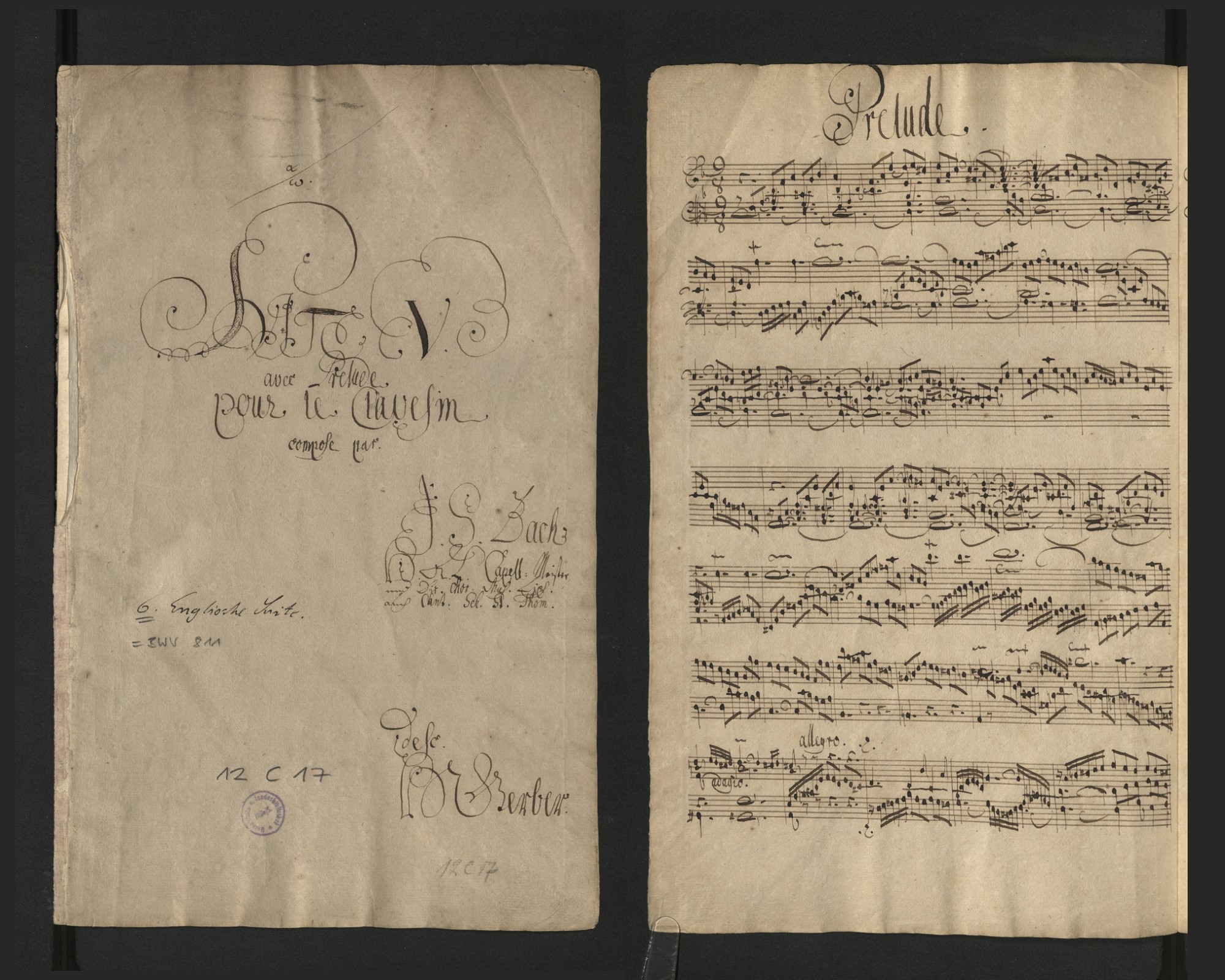 Gerber's manuscripts were considered lost for decades. Later they were privately owned by the British pharmacologist, musician, Bach lover and patron Sir Ralph Kohn (1927–2016), who was born in Leipzig as the child of a Jewish Orthodox textile merchant. In 1933, Ralph Kohn and his family had to flee Leipzig to escape the Nazis, but remained emotionally attached to his native city and its rich musical tradition throughout his life. On 1 February 2024, the Director of the Bach Archive Leipzig, Prof. Dr. Dr. h.c. Peter Wollny, presented the four sources to the public for the first time at a press event.
Gerber's manuscripts were considered lost for decades. Later they were privately owned by the British pharmacologist, musician, Bach lover and patron Sir Ralph Kohn (1927–2016), who was born in Leipzig as the child of a Jewish Orthodox textile merchant. In 1933, Ralph Kohn and his family had to flee Leipzig to escape the Nazis, but remained emotionally attached to his native city and its rich musical tradition throughout his life. On 1 February 2024, the Director of the Bach Archive Leipzig, Prof. Dr. Dr. h.c. Peter Wollny, presented the four sources to the public for the first time at a press event.
Prof. Dr. Peter Wollny: »Sir Ralph Kohn was a founding member of the Board of Trustees of the Leipzig Bach Archive and donated two of the copies to it in 2011. This year we received the other two as a gift from his daughter Michelle Kohn. I am deeply grateful to the Kohn family for giving us the opportunity to show these four important sources together in public for the first time in the treasury room of the Bach Museum Leipzig.«
> Here you will find the scans of the manuscripts in the Digital Collections.
At an auction held by the London auction house Sotheby's in 2021, the Bach Archive Leipzig acquired the original manuscript of the composer Carl Philipp Emanuel Bach, previously thought to have been lost. The rare early work had been composed in Leipzig in 1731. On April 13, Dr. Skadi Jennicke, mayor and councillor for culture of the city of Leipzig, and Prof. Dr. Dr. h. c. Peter Wollny, director of the Bach Archive, presented the freshly restored score including the set of parts to the public.
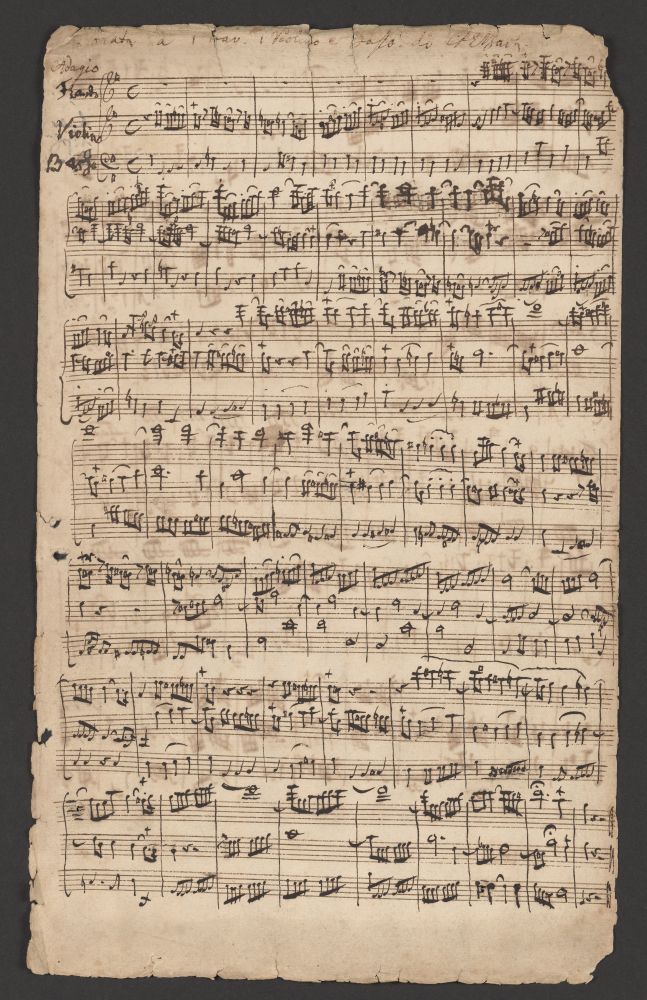 The composer had written the three-movement piece for violin, flute and basso continuo at the age of 17 under the eyes of his father and revised it in later years. With the purchase by the Bach Archive Leipzig, this singular source material on Bach reception returns to the place of its creation – Leipzig's Thomaskirchhof. Here, for the first time, it is permanently accessible to the public.
The composer had written the three-movement piece for violin, flute and basso continuo at the age of 17 under the eyes of his father and revised it in later years. With the purchase by the Bach Archive Leipzig, this singular source material on Bach reception returns to the place of its creation – Leipzig's Thomaskirchhof. Here, for the first time, it is permanently accessible to the public.
Prof. Dr. Dr. h. c. Peter Wollny, director of the Bach Archive Leipzig: »The composer Carl Philipp Emanuel Bach destroyed most of his early Leipzig works himself in later years. It is therefore significant both for the city of Leipzig and for music research that the score and parts of a Bach trio sonata written in 1731 and later revised now enrich the collection of the Bach Archive Leipzig. The work was penned by a 17-year-old influenced by the rich musical cosmos of Leipzig. The aura of the bustling Cantor's apartment at the Thomaskirchhof, the education at the Thomasschule and student music-making shaped a young musician who later went down in music history as one of the most important composers of the 'Empfindsamkeit' and a highly respected music director of the city of Hamburg.«
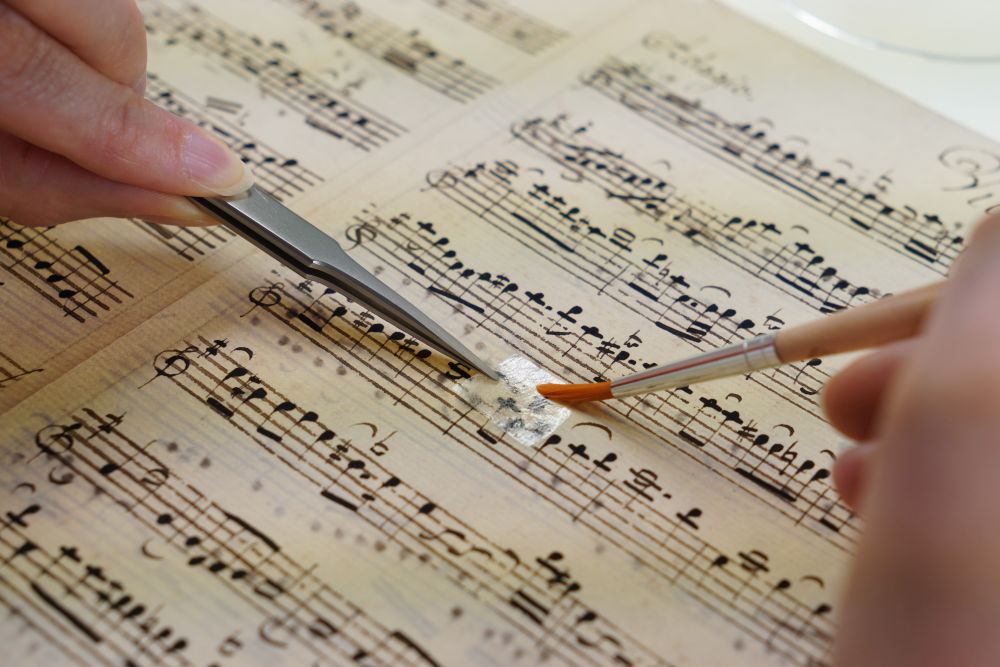 Acquired with the generous support of private donors Barbara Lambrecht-Schadeberg, Adelheid and Jon Baumhauer, and Dr. Arend Oetker, the autograph manuscript of music had been preserved in the estate of Handel scholar Friedrich Chrysander (1826–1905) and remained in the possession of his descendants until the auction. Following the purchase, the source material was extensively restored by Schempp Bestandserhaltung GmbH in Kornwestheim, a company specializing in the preservation of archival and library materials.
Acquired with the generous support of private donors Barbara Lambrecht-Schadeberg, Adelheid and Jon Baumhauer, and Dr. Arend Oetker, the autograph manuscript of music had been preserved in the estate of Handel scholar Friedrich Chrysander (1826–1905) and remained in the possession of his descendants until the auction. Following the purchase, the source material was extensively restored by Schempp Bestandserhaltung GmbH in Kornwestheim, a company specializing in the preservation of archival and library materials.
Dr. Skadi Jennicke, mayor and councillor for culture of the city of Leipzig: »The city of music Leipzig is visible to the outside world from afar through its famous institutions, traditional sites and popular events. But its foundation lies in the treasure of its musical monuments: the valuable manuscripts and printed editions that have been collected here for more than five centuries. They form the significant heritage that must be cultivated, increased, researched and prepared for practical use. The Bach Archive, too, was once founded to preserve the compositions of the Bach family located in Leipzig. In recent years, the archive's unique collection has been successfully expanded and has become a magnet for scholars and musicians from all over the world. I am delighted that the trio sonata written in Leipzig, a rare original manuscript by the young Carl Philipp Emanuel Bach, has now joined this collection.«
> Here you will find the scans of the manuscript in the Digital Collections.
The Bach Archive Leipzig succeeded in acquiring a copy of the first Bach Edition (published in Leipzig between 1851 and 1900) from the possession of the composer Gustav Mahler. Four of the volumes contain extensive inscriptions in Mahler's hand. Inserted are handwritten sheets of music with Mahler's arrangement of the Gavotte from Bach's Overture BWV 1068. The 59-volume edition was previously in private hands in London. The purchase was made possible by funds from the B.H. Breslauer Foundation, the Kulturstiftung der Länder, and with the support of numerous private donors.
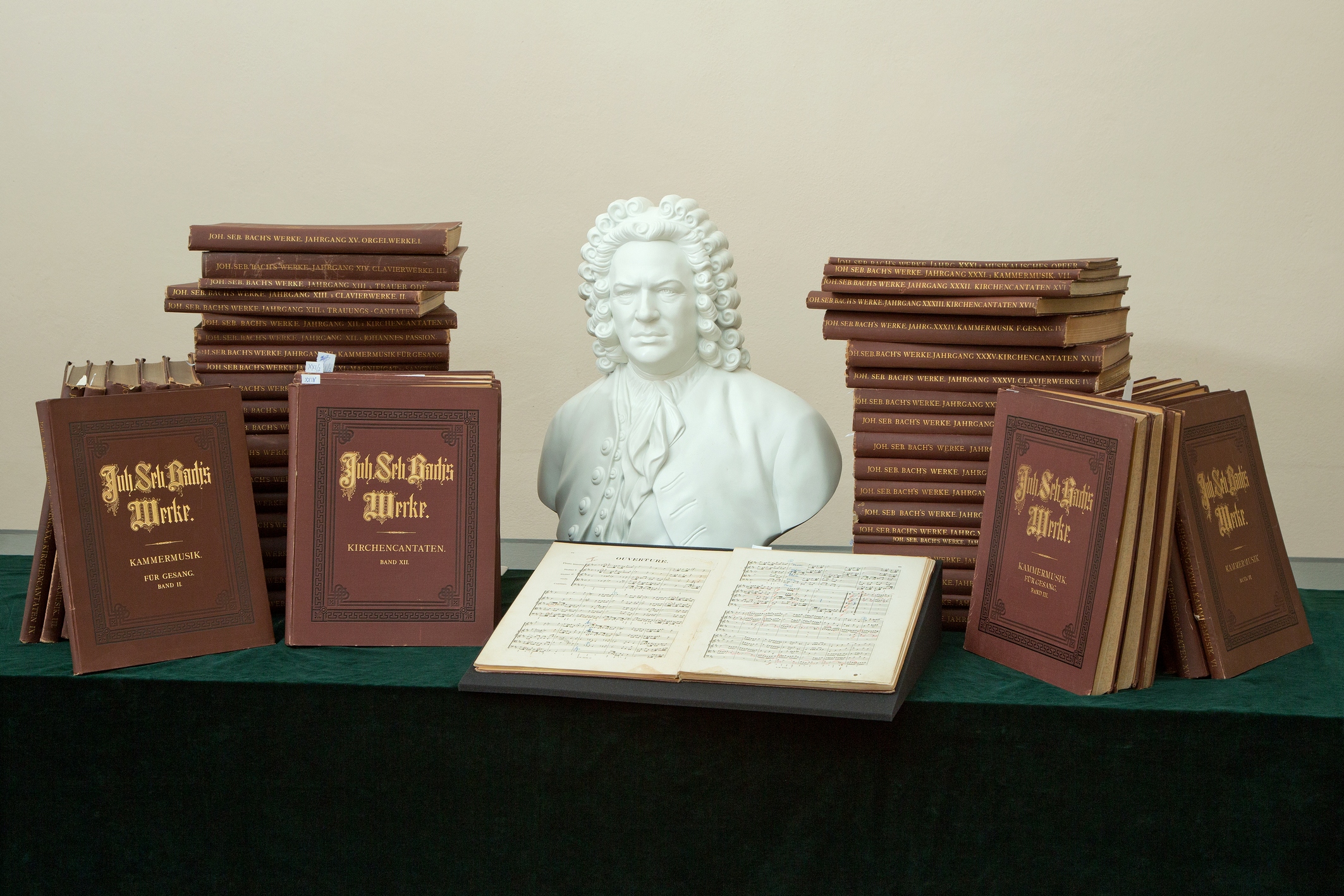
On 10 November 1909, Gustav Mahler conducted his »Bach Suite« for the first time as part of a series of »Historical Concerts« he had established in New York. For this, he arranged parts of Johann Sebastian Bach's second and third orchestral suites and assembled them into a symphonic work. It remains to be investigated when Mahler began to occupy himself intensively with the works of Bach. It is probable that he subscribed to the Bach Edition during his Leipzig years (1886–1888).
This first complete edition of Bach's works was initiated in 1850 at the instigation of renowned Leipzig and international musicians and was editorially supervised by the Bach Gesellschaft, which was founded for this purpose. The promotion of Bach's music in Leipzig, once established by Felix Mendelssohn Bartholdy, flourished at this time, and Bach's orchestral suites had a permanent place in the repertoire of the Leipzig Gewandhausorchester, which the young Gustav Mahler conducted regularly as Kapellmeister of the Leipzig Municipal Theater.
After Mahler's time in Leipzig, the Bach Edition found a dignified place in his composer's cottage in Maiernigg on Lake Wörthersee (according to his wife Alma, in addition to a grand piano and the complete editions of Goethe and Kant, »only Bach« was to be found in this little cottage). He left 59 of a total of 61 published volumes to his heirs – only volume IV (St. Matthew Passion) and the supplementary volume, which was published only after Mahler's death, are missing. Four of the volumes (Christmas Oratorio, Art of Fugue, Orchestral Suites, Violin Sonatas) contain handwritten entries, some of them extensive. These document Gustav Mahler's analytical and artistic understanding of Bach's music, provide valuable insights into his interpretations, and illuminate numerous aspects of his performance practice. Of particular value is Mahler's arrangement of the Gavotte from the Third Orchestral Suite, which is included as an autograph.
The provenance of the volumes can be traced without gaps: After Gustav Mahler's death, his widow Alma Mahler-Werfel inherited the Bach Edition. After her death in 1964, they passed into the possession of Mahler's daughter Anna Mahler (until 1988) and later into that of his granddaughter Marina Fistoulari-Mahler. At an auction held by Sotheby's on May 29, 1992, a London private collector finally bought the edition.
With the purchase of the described copy of the Bach Edition by the Bach Archive Leipzig, this singular source material on Gustav Mahler's reception of Bach is for the first time and moreover permanently accessible to the public for musicological research.
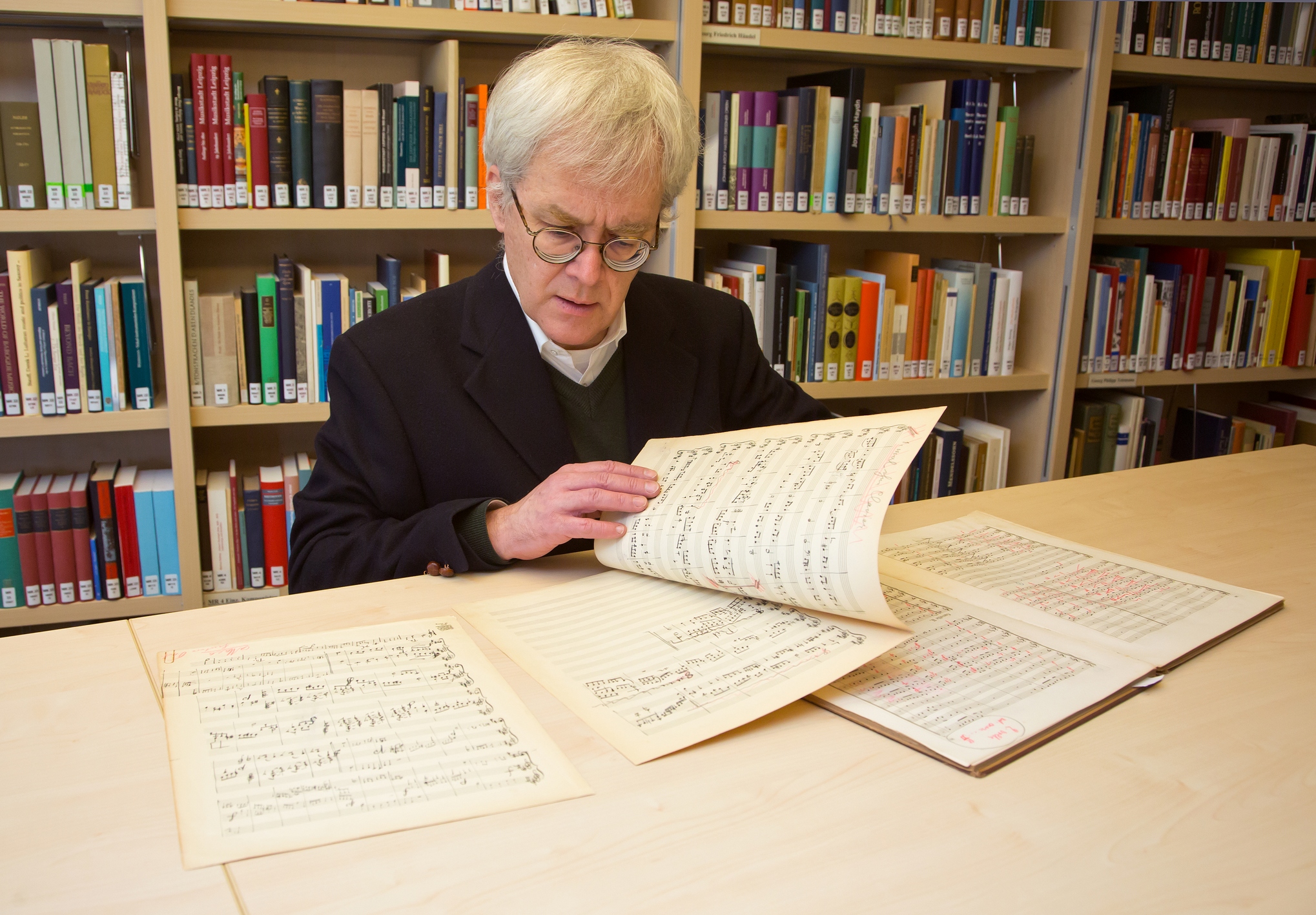 Prof. Dr. Dr. h. c. Peter Wollny, Director of the Bach Archive Leipzig: »Until now, the volumes have always been in private hands and have never been available for scholarly evaluation. The potential for new insights and a revised evaluation of Mahler's Bach interpretations seems very high. I am grateful to all the patrons for their generous support of this important acquisition.« The plan is to display the volumes publicly as part of a special exhibition at the Bach Museum Leipzig.
Prof. Dr. Dr. h. c. Peter Wollny, Director of the Bach Archive Leipzig: »Until now, the volumes have always been in private hands and have never been available for scholarly evaluation. The potential for new insights and a revised evaluation of Mahler's Bach interpretations seems very high. I am grateful to all the patrons for their generous support of this important acquisition.« The plan is to display the volumes publicly as part of a special exhibition at the Bach Museum Leipzig.
Prof. Dr. Markus Hilgert, Secretary General of the Kulturstiftung der Länder: »Gustav Mahler's copy of the complete edition of Bach's works makes it possible to understand how Mahler understood Bach and how he interpreted and performed his works. With the purchase for the Bach Archive Leipzig, the edition returns to Bach's main place of activity and can be presented to a broad public there. Until now, the edition was exclusively in private hands – now, for the first time, it can be comprehensively examined and made accessible to researchers worldwide. I look forward to many new insights into Mahler's view of Bach and the Bach reception of the early 20th century.«
> Here you will find the scans of Mahler's handwritten entries in the Digital Collections.
The Leipzig Bach Archive has expanded its collection with a previously unpublished letter by Carl Philipp Emanuel Bach. It is a two-page letter with extraordinary provenance, which the Hamburg music director Bach wrote to the Leipzig publisher Engelhard Benjamin Schwickert two years before his death.
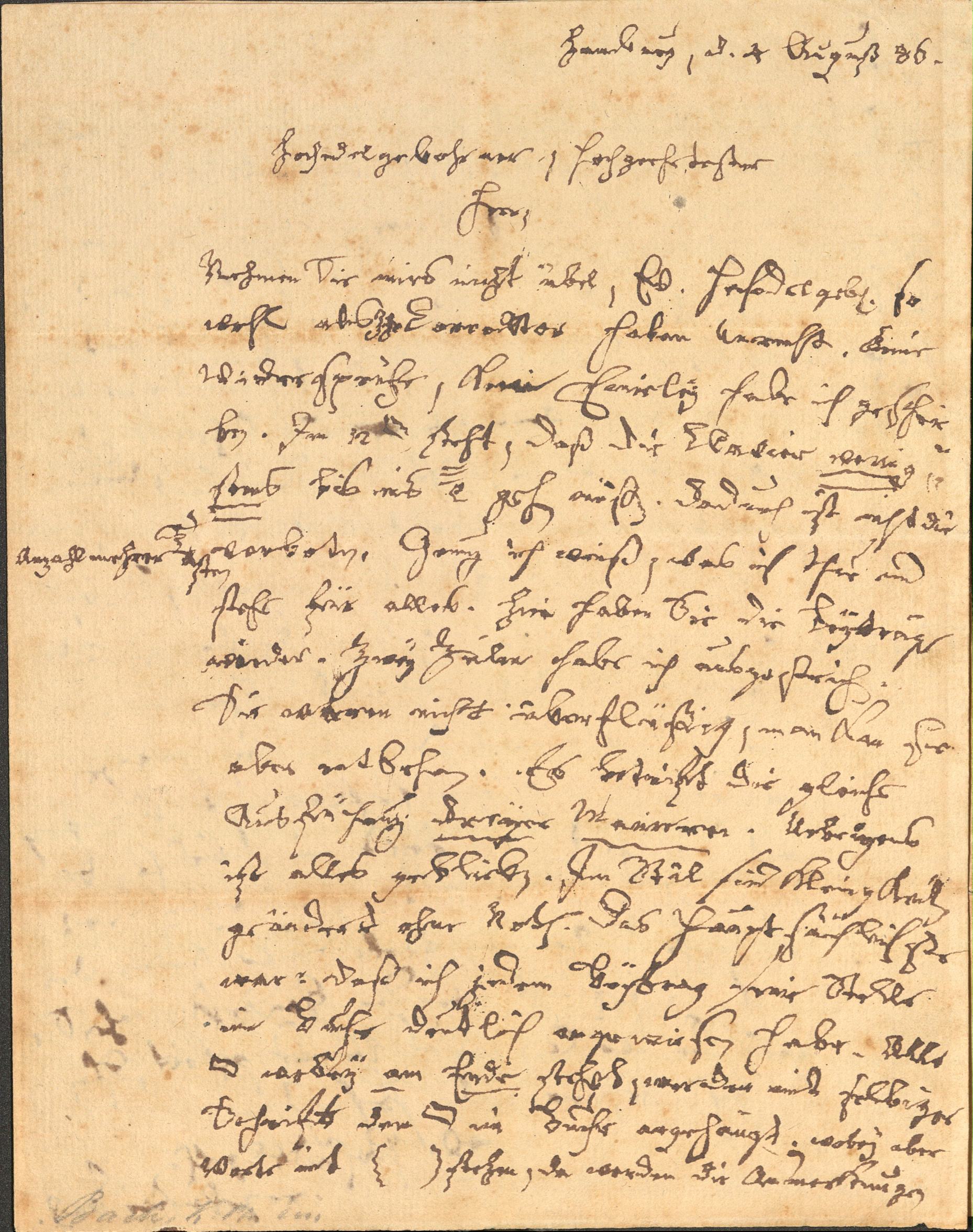
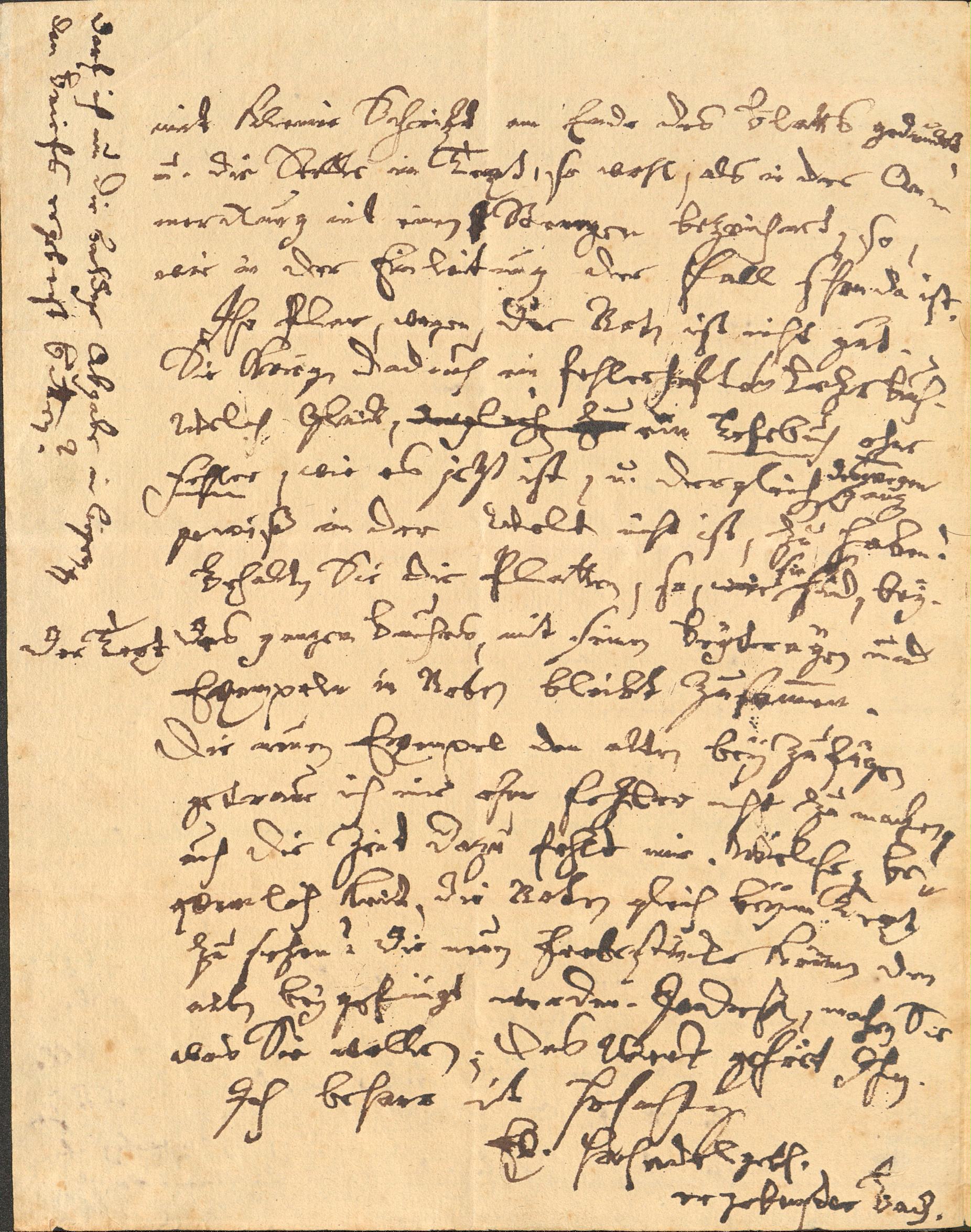
The letter is dated 4 August, 1786 and deals with a new edition of Carl Philipp Emanuel Bach's »Versuch über die wahre Art das Clavier zu spielen« - one of the most important musical textbooks of the 18th century. Among other things, Bach writes to Schwickert: »What luck, a textbook without errors, as it is now, and there is certainly no such thing in the world!«. The purchase complements the extensive letter collection of the family of Carl Philipp Emanuel Bach, which is kept in the Bach Archive in Leipzig. It includes 39 letters from the composer (Kulukundis collection) and 37 letters from his daughter Anna Carolina Philippina Bach.
as it is now, and there is certainly no such thing in the world!«. The purchase complements the extensive letter collection of the family of Carl Philipp Emanuel Bach, which is kept in the Bach Archive in Leipzig. It includes 39 letters from the composer (Kulukundis collection) and 37 letters from his daughter Anna Carolina Philippina Bach.
Prof. Dr. Dr. H. c. Peter Wollny, director of the Leipzig Bach Archive:»The return of an unknown letter from the second Bach son to his original destination is a special stroke of luck. The contentful letter illustrates C. P. E. Bach's efforts for a new edition of his piano school and, with its numerous details, reflects a piece of real life from the late 18th century. Since the Bach Archive already holds two letters from C. P. E. Bach to the Leipzig publisher Schwickert, new perspectives are opening up for scientific research.«
In the more than 230 years after it was written, the letter and its respective owners migrated from Leipzig via Berlin and Vienna to New York and most recently to Miami Beach. There the letter was part of the »John and Johanna Bass Collection«. The Jewish couple John and Johanna Bass, originally from Vienna, donated their important private art collection to the city of Miami Beach in 1963 – on the condition that it be made accessible to the public in a museum. As a result, the Bass Art Museum opened in Florida in 1964.
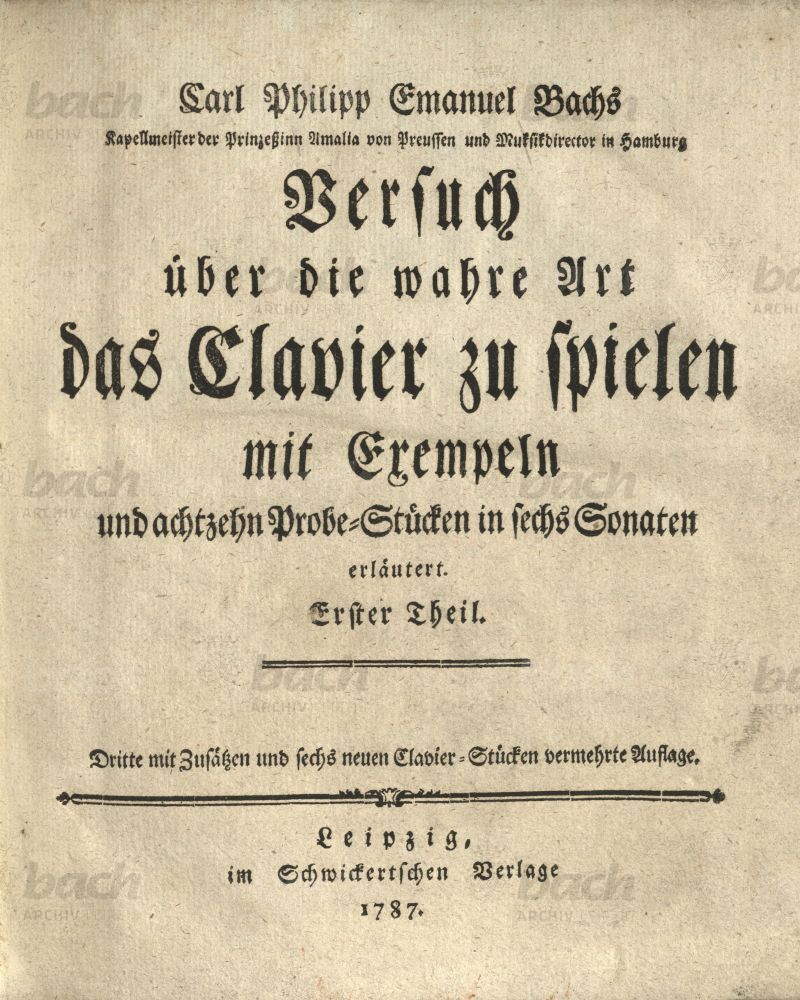 John Bass, a successful businessman, came to New York in 1914 via Paris and in 1925 he joined the Puerto Rican-based Fajardo Sugar Company, in which he rose to become its president. The Bass couple probably bought Bach's letter in 1934 at an auction of the Artaria & Co company in Vienna, in which the estate of Alfred Freiherr von Liebieg (1854–1930) was sold. Presumably there were personal or business relationships between the Bass couple and the Liebieg family: Alfred von Liebieg himself worked in Vienna as a sugar industrialist. Alfred von Liebieg had probably bought the letter in 1901 at an auction of the Berlin antiquarian Leo Liepmannssohn. The provenance in the 19th century is unclear, possibly the letter - like another letter from C. P. E. Bach to Schwickert - was formerly part of the then famous letter collection of Alfred Bovet (1841–1900).
John Bass, a successful businessman, came to New York in 1914 via Paris and in 1925 he joined the Puerto Rican-based Fajardo Sugar Company, in which he rose to become its president. The Bass couple probably bought Bach's letter in 1934 at an auction of the Artaria & Co company in Vienna, in which the estate of Alfred Freiherr von Liebieg (1854–1930) was sold. Presumably there were personal or business relationships between the Bass couple and the Liebieg family: Alfred von Liebieg himself worked in Vienna as a sugar industrialist. Alfred von Liebieg had probably bought the letter in 1901 at an auction of the Berlin antiquarian Leo Liepmannssohn. The provenance in the 19th century is unclear, possibly the letter - like another letter from C. P. E. Bach to Schwickert - was formerly part of the then famous letter collection of Alfred Bovet (1841–1900).
In 2019, the New York-based antiquarian J. & J. Lubrano exclusively offered the manuscript to the Leipzig Bach Archive. The purchase was made possible with the generous support of the »Beauftragte der Bundesregierung für Kultur und Medien«, the American Friends of the Leipzig Bach Archive and the Packard Humanities Institute (Los Altos, California) as well as substantial private donations.
> Here you will find the scans of the letter in the Digital Collections.
Following the handover of the 44 original parts of Bach's »Choralkantaten-Jahrgang« in 1951 and an expansion of this permanent loan in 1980 to include 62 outstanding individual items on the music of the Thomaskantors from the 17th to 19th centuries, we were able to add a further 700 pieces to the Thomana collection in April 2019.
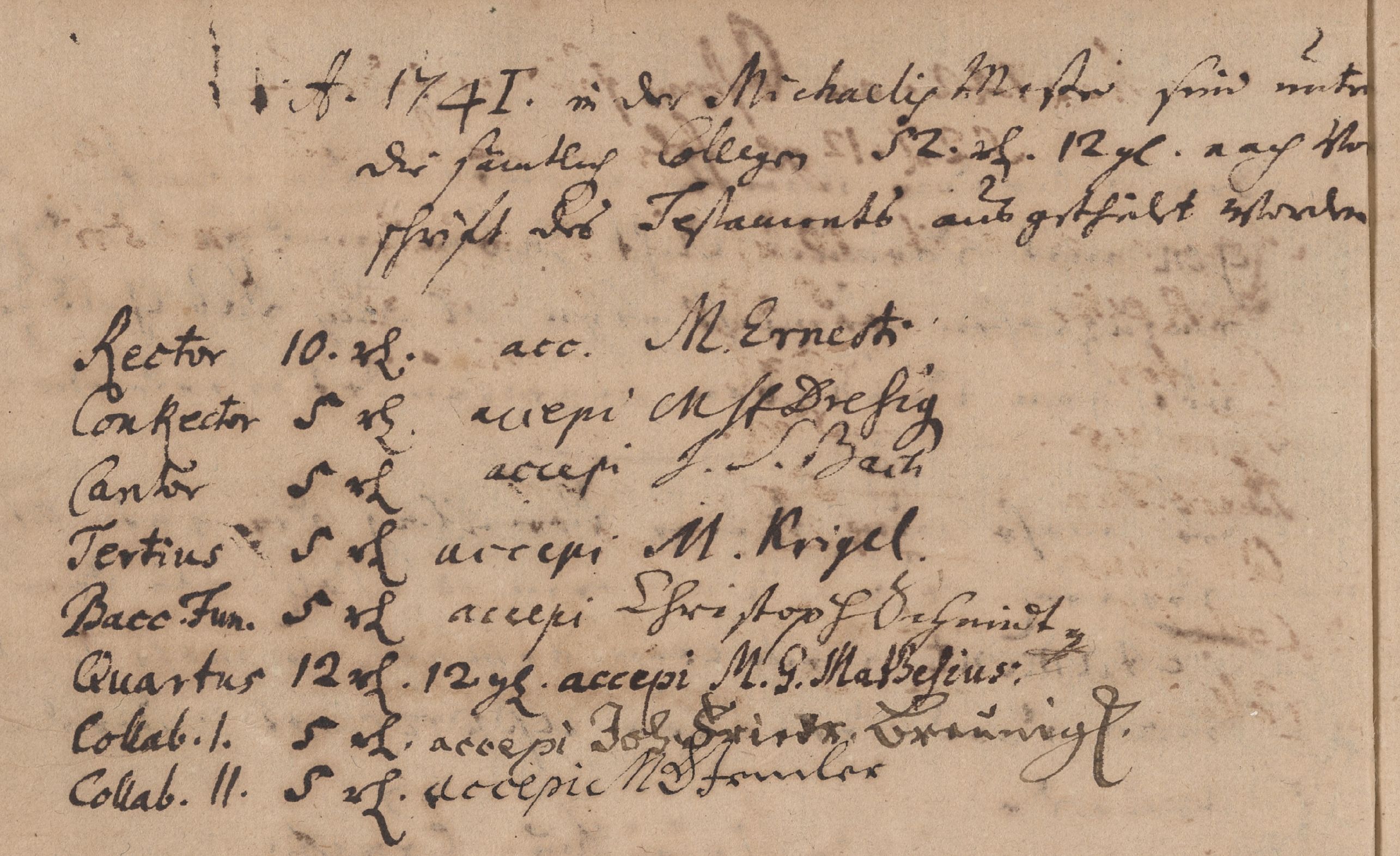 The manuscripts and prints contained in the collection date back to the 15th century and include teaching materials, matriculation and receipt books as well as manuscripts, first printings and historical performance materials from the choir library. The collection thus forms a unique treasure that not only documents the history of the St Thomas's Choir, but is equally testimony to the school, cultural and everyday history of the Thomana as a whole. Many discoveries still lie dormant in the largely unexplored documents, which musicology and especially Bach research will take up in the coming years and decades.
The manuscripts and prints contained in the collection date back to the 15th century and include teaching materials, matriculation and receipt books as well as manuscripts, first printings and historical performance materials from the choir library. The collection thus forms a unique treasure that not only documents the history of the St Thomas's Choir, but is equally testimony to the school, cultural and everyday history of the Thomana as a whole. Many discoveries still lie dormant in the largely unexplored documents, which musicology and especially Bach research will take up in the coming years and decades.
The acquisition of the collection was preceded in September 2018 by an initial review and in February 2019 by a thorough selection and recording of individual titles in the rooms of the Thomasalumnat. Supported by the expertise of the then managing director Dr Stefan Altner and his assistant Felicitas Kirsten, who had held the collection together and looked after it over the past decades, the far-reaching musical and cultural-historical significance of the holdings quickly became clear: The oldest document in the collection is an illuminated Venetian incunabulum from 1471, which has survived from the former school library. 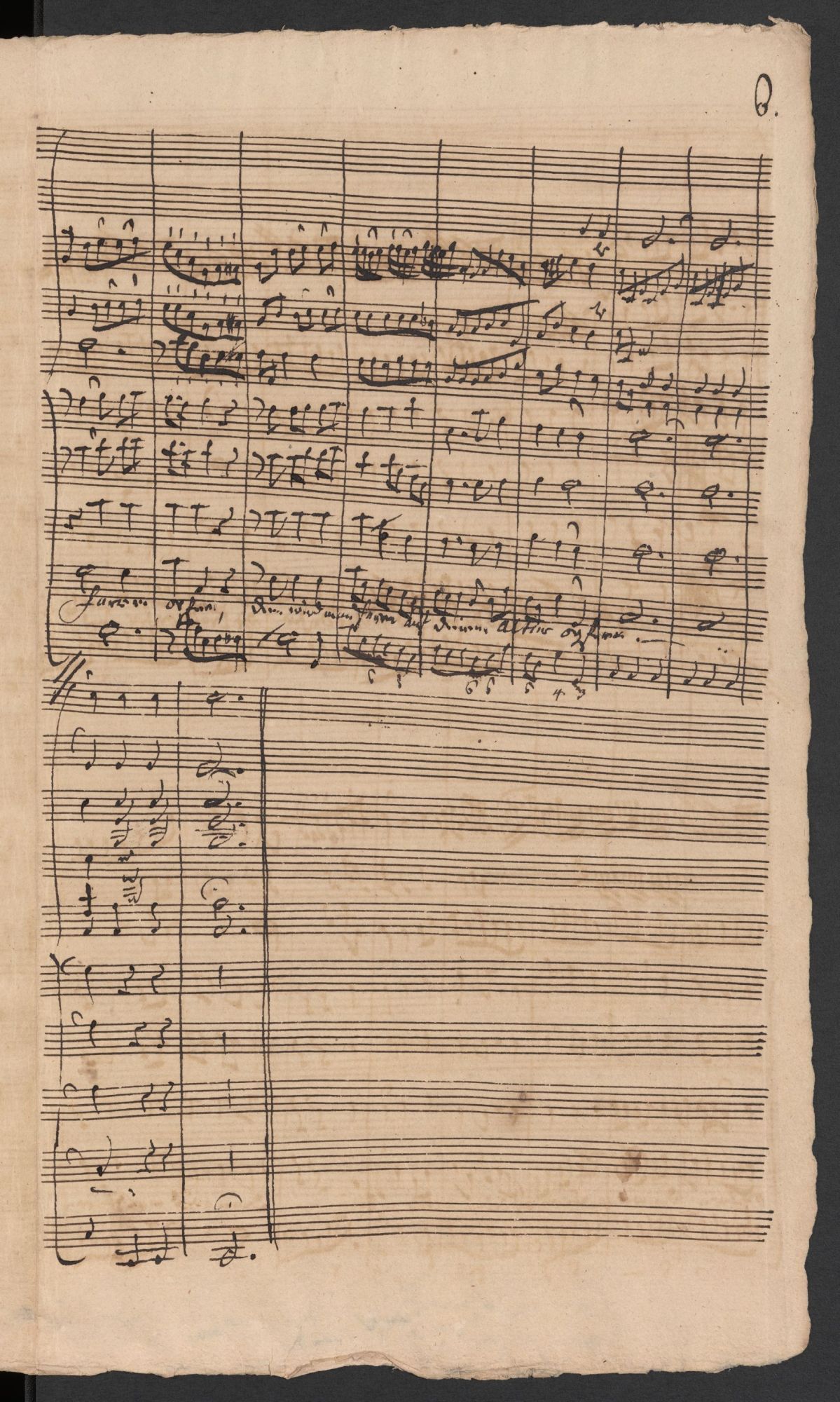 The first handwritten lists of pupils date from the 17th century and provide an almost complete insight into the choir's membership, age and social structures up to the Bach era and beyond. Several receipt books document additional income received by the Thomas School teachers from foundations from Leipzig citizens; among them is a book with 14 signatures of Johann Sebastian Bach alone, documenting the receipt of half-yearly legacy payments in the years from 1741 to 1750. Bach's pupil and successor in office Johann Friedrich Doles (1715–1797) left an autograph fragment with the last bars of a cantata on Psalm 51 »Gott sei mir gnädig« (God be gracious to me), which was thought to have been lost. From more recent times, the personal copy of the Bach Complete Edition by Karl Straube (1873–1950) has been preserved; it documents the numerous practical performance decisions of the Thomaskantor when he first performed Bach's cantata work almost completely on the radio with the Thomanerchor between 1931 and 1937. From the period after the Second World War, a handwritten chronicle of the choir's concerts and concert tours from the 1950s deserves special mention.
The first handwritten lists of pupils date from the 17th century and provide an almost complete insight into the choir's membership, age and social structures up to the Bach era and beyond. Several receipt books document additional income received by the Thomas School teachers from foundations from Leipzig citizens; among them is a book with 14 signatures of Johann Sebastian Bach alone, documenting the receipt of half-yearly legacy payments in the years from 1741 to 1750. Bach's pupil and successor in office Johann Friedrich Doles (1715–1797) left an autograph fragment with the last bars of a cantata on Psalm 51 »Gott sei mir gnädig« (God be gracious to me), which was thought to have been lost. From more recent times, the personal copy of the Bach Complete Edition by Karl Straube (1873–1950) has been preserved; it documents the numerous practical performance decisions of the Thomaskantor when he first performed Bach's cantata work almost completely on the radio with the Thomanerchor between 1931 and 1937. From the period after the Second World War, a handwritten chronicle of the choir's concerts and concert tours from the 1950s deserves special mention.
Digital copies of the most valuable pieces of this collection expansion are available in our Digital Collections.
In December 2017 the Leipzig Bach-Archive was able to acquire 37 autograph letters from Carl Philipp Emanuel Bach’s daughter Anna Carolina Philippina. The documents provide unique insights into the heirs’ dealing with the musical legacy of the Hamburg capellmeister who had died in 1788. They also increase our knowledge on the distribution of sheet music in the late 18th century.
> Here you will find the scans of the letters in the Digital Collections.
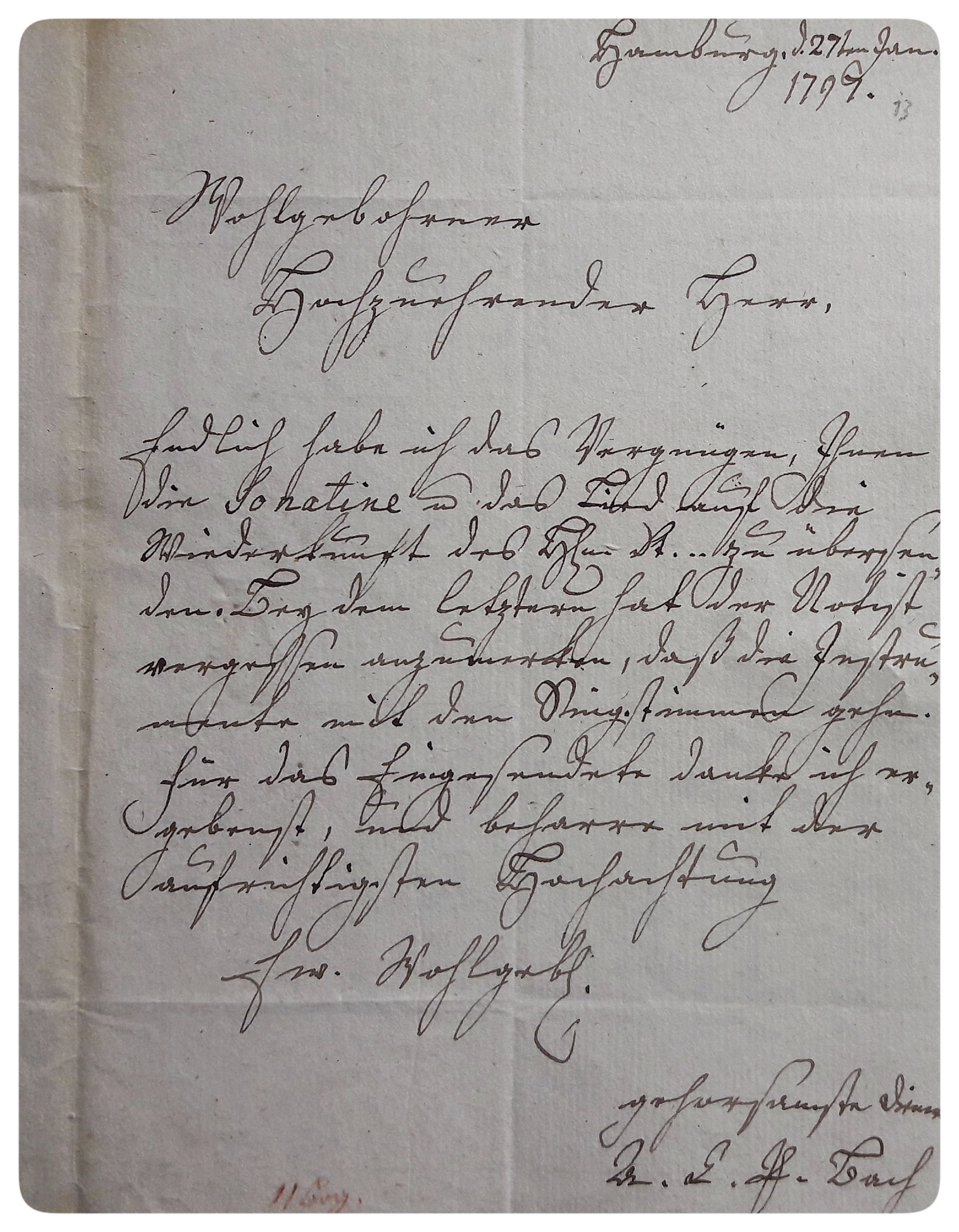
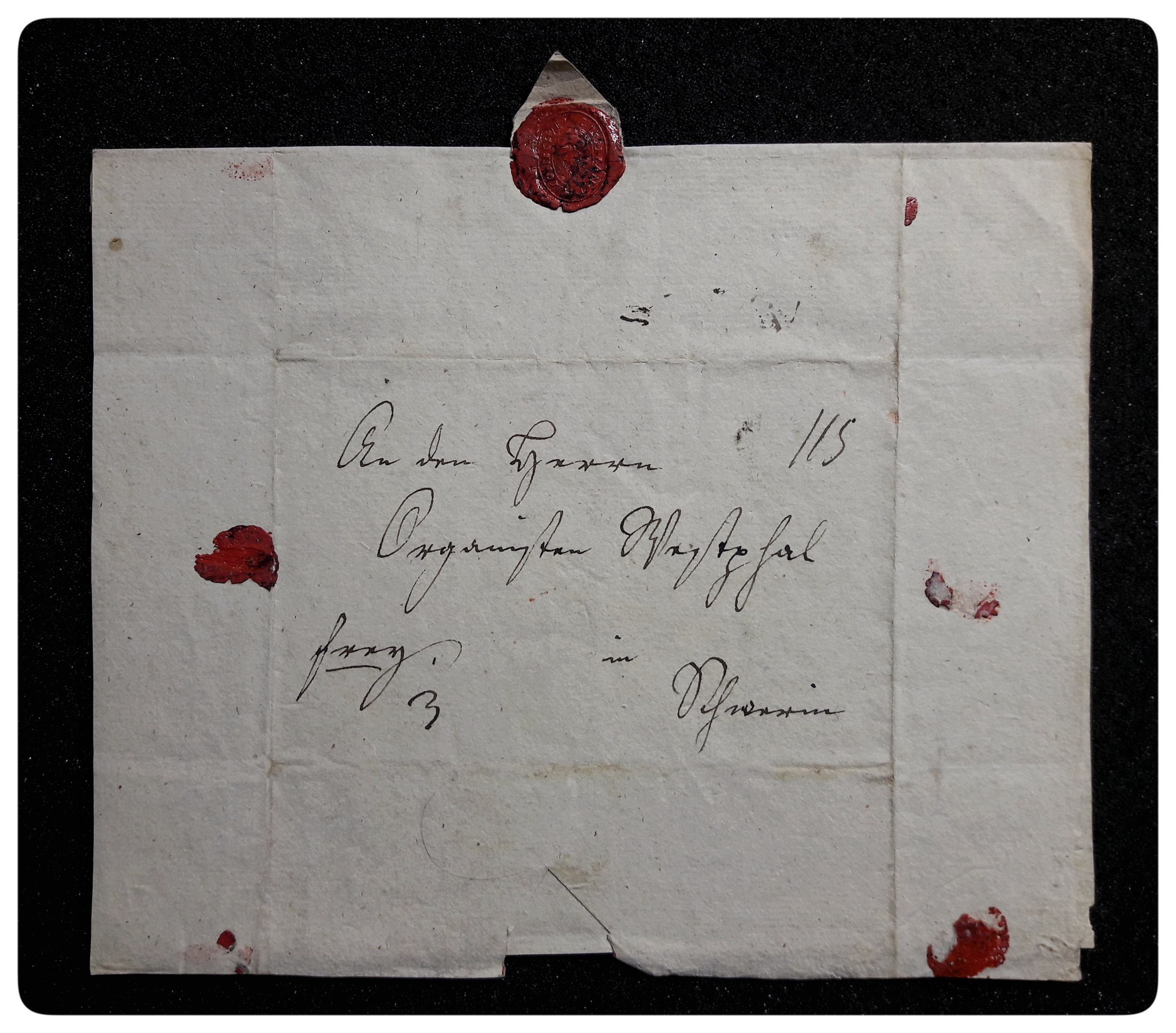
Very recently the Bach-Archive was able to extend its collection of handwritten documents by Leipzig Thomaskantors. With the assistance of the American Friends of the Leipzig Bach Archive we acquired a hitherto unknown autograph by Johann Adam Hiller (1728–1804).
 From 1781 Hiller was the first musical director of the Gewandhausorchester and following Johann Sebastian Bach and Johann Friedrich Doles he was Thomaskantor from 1789 to 1801. His repertoire at the churches and in the concerts was mainly shaped by the works of other composers, including Giovanni Battista Pergolesi, George Frederic Handel, Joseph Haydn and Wolfgang Amadeus Mozart.
From 1781 Hiller was the first musical director of the Gewandhausorchester and following Johann Sebastian Bach and Johann Friedrich Doles he was Thomaskantor from 1789 to 1801. His repertoire at the churches and in the concerts was mainly shaped by the works of other composers, including Giovanni Battista Pergolesi, George Frederic Handel, Joseph Haydn and Wolfgang Amadeus Mozart.
The newly acquired autograph contains Hillers preface to his Latin translation of George Frederic Handel’s Utrecht Te Deum. Handel had composed the piece already in 1713 to celebrate the Peace of Utrecht. For a Leipzig performance in 1779 Hiller prepared an arrangement replacing the original English lyrics by Latin words. This work was published in Leipzig the following year.
Together with Hiller’s edition of arias, duets and choirs from the Messiah it determined the German reception of Handel’s music well into the 19th century.
> Here you will find the scans of the manuscript in the Digital Collections.
The Bach Archive Leipzig received three volumes (I, III, V) of the German edition of the »Sämtliche Orgelwerke« (Complete organ works) by J. S. Bach, edited by Charles-Marie Widor and Albert Schweitzer, as a gift from the Musikhochschule Münster. The volumes are very rare and not preserved in any other German library.

Albert Schweitzer (1875–1965) studied organ in Paris with French organist Charles-Marie Widor (1844–1937) and the two became good friends. Widor encouraged Schweitzer to write down his ideas about Bach’s works in French: In 1905 his book was published under the title J.-S. Bach, le musicien-poète; the completely revised and expanded German version was published in 1908. The main emphases of this Bach book were not biographical aspects but rather the interpretation of the essence of his music. Schweitzer declared: »As a musician I wanted to talk to other musicians about Bach’s music«.
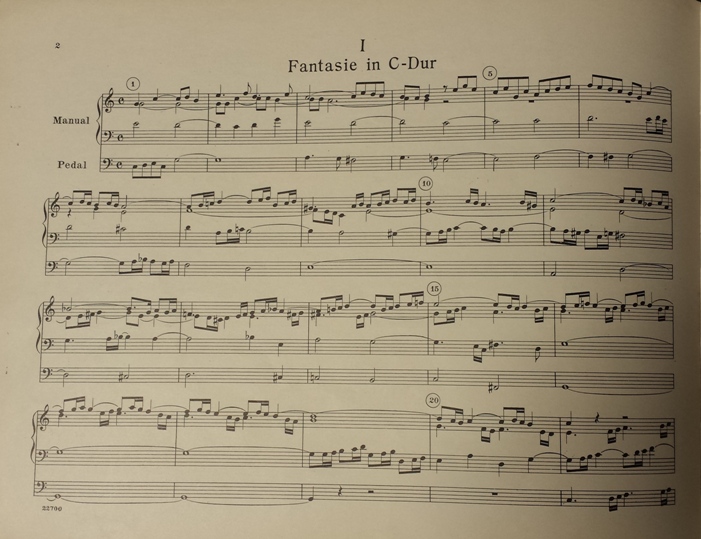
In 1907 the New York publishing company G. Schirmer commissioned Widor and Schweitzer to edit a new edition of Bach’s organ works with detailed analysis of each work in three languages (English, French and German). Schweitzer insisted that the score should show Bach’s notation with no additional markings, which was different to the previous editions. The first five volumes were published between 1912 and 1914. The last three volumes were published 1954 (VI) and 1967 (VII+VIII) and only in English language; a continuation of the German and French edition was not planned.
> Here you will find the entry of the edition in the Bach Bibliography.
A long-lost portrait of the Berlin composer and Bach’s grandson Wilhelm Friedrich Ernst Bach (1759–1845) was given to the Bach-Archive as a permanent loan by the Sing-Akademie zu Berlin. The picture is as ascribed to the Berlin portraitist Eduard Magnus who painted it at the behest of Felix Mendelssohn Bartholdy around 1844. In 1843 Wilhelm Friedrich Ernst Bach has been travelled to Leipzig to join the inauguration of the Leipzig Bach monument that was founded by Mendelssohn. In 2012 the portrait appeared at an art dealer in Munich. In Leipzig it will be hang up in the treasure room of the Bach-Museum.

In the year of the 200th anniversary of Matthias Claudius’ death the Leipzig Bach Archive was able to acquire a long-lost letter by the poet, reporting about a private concert at Carl Philipp Emanuel Bach’s Hamburg apartment in October 1768.

It must have been a great pleasure to listen to C. P. E. Bach playing the clavier. In October 1768 the German poets Matthias Claudius and Gotthold Ephraim Lessing were guests at Bach’s Hamburg apartment. In a letter to his friend Heinrich Wilhelm von Gerstenberg Claudius reported about that event: »I myself was not able to make him play; that is why I asked Lessing to take me along.«
At that time Bach was the director of music in Hamburg for not even a year. Meanwhile not only his playing but also his special instrument was known throughout the city: »The famous little Silbermann Clavier has a clear, pervasive, sweet sound, the basso is particularly not powerful, the descant is particularly not soft and reaches just e’’’. On this clavier Bach played two Adagios and an Allegro, which he had composed particularly for this clavier.«
Claudius compares Bach’s playing with the prudent talk of an orator. Maybe this view on his playing caused him to ask Bach to play his Fantasia in C minor (from the sonata Wq 63/6). The piece was considered to be the paragon of the so called ›speaking principle‹. To illustrate the powerful eloquence of this Fantasia, Heinrich Wilhelm von Gerstenberg goes so far to set several lyrics to its tune.
> Here you will find the scans of the letter in the Digital Collections.
Moreover: Please find Carl Philipp Emanuel Bach's Fantasia in C minor in our youtube-Channel, played by Jean-Christophe Dijoux, prize winner of the XIX. International Bach Competition Leipzig 2014
After 265 years, the famous 1748 portrait of Bach by the Leipzig painter Elias Gottlob Haussmann has returned to Leipzig. This was made possible by the late American musicologist and philanthropist Dr. William H. Scheide, who designated Leipzig Bach Archive as the beneficiary of the painting on the occasion of his 100th birthday. The portrait is now part of our collection and will be permanently exhibited in the Bach Museum.

The portrait shows Johann Sebastian Bach in a formal pose at around 60 of age. In his right hand, he holds a sheet bearing the Canon triplex à 6 Voc: per J. S. Bach as proof of the sophistication of his craftsmanship. Haussmann painted two versions of the portrait. The second original, painted in 1748, is in a much better state of conservation. This is a captivating portrait, not only because of its glowing colours and sharp outlines, but also because of its moving history. The 1748 portrait was part of Carl Philipp Emanuel Bach’s share of his father's inheritance and was once displayed as part of the voluminous collection of portraits belonging to Bach’s second-eldest son in Hamburg. The catalogue of the estate of the »Hamburg Bach« from 1790 describes it as follows: »Bach (Johann Sebastian) Kapellmeister and Music-director in Leipzig. Painted in oils by Hausmann. 2 feet, 8 inches high, 2 feet, 2 inches wide. In a golden frame«.
From the early nineteenth century, the painting was owned by the Jewish Jenke family from Breslau (now Wroclaw). Walter Jenke, a descendant of the erstwhile purchasers, was forced to emigrate from Germany in the 1930s. To protect the painting from air raids, Jenke kept the portrait at the country home of his friends, the Gardiners, in Dorset. As a result, Sir John Eliot Gardiner, former President of Bach Archive, grew up under Bach’s gaze.
In 1952, the Bach researcher and collector William H. Schieide, a Princeton, New Jersey resident, bought the painting in an auction. Scheide, who in the Bach anniversary year of 1985 had already expressed his wish to see »his Bach« return home one day, granted the Leipzig Bach Archive the exclusive right of first refusal when he visited the Leipzig Bach Festival in 2003. Together with his wife Judith, he finally bequeathed the painting to the Bach Archive. Bill Scheide died on November 14, 2014. As a member of the Board of Trustees of Leipzig Bach Archive Foundation since 2001, he had been one of the Archive’s most generous and loyal sponsors.
For several years, the Bach Archive has endeavored to reconstruct Bach's theological library. In the »Specificatio der Verlaßenschaft des seelig verstorbenen Herrn Johann Sebastian Bachs« – i. e. the inventory of Bach's estate from 1750, which has been preserved at the Leipzig State Archives – there is a list of more than three dozen titles of spiritual books, which convey an impression of Bach's far-reaching theological interests. Through acquisitions in the international antique market, the Bach Archive is now trying to reconstruct Bach's book theological library in the form of parallel copies of the works recorded in his ledger.

Bach possessed many editions of the »Apostolische Schlußkette und Krafft-Kern oder gründliche Außlegung der gewöhnlichen Sonn- und Festtagsepisteln« (here shown in the third edition from 1680), a work by the Rostock theologian Heinrich Müller (1631-1675), whose writings were widely used in the 17th and 18th centuries in Protestant areas. Thoughts and linguistic images of his Passion sermons served as a model for Christian Friedrich Henrici, alias Picander, who wrote the libretto of Bach's St. Matthew Passion.
A particularly fine item of the very rare first edition of Johann Kuhnau’s »Neue Clavier-Übung« (1689) was acquired by the Bach-Archive – puchased at the auction house Sotheby’s already in 2012.

An unknown portrait of Bach's mélomane employer from 1717 to 1723, Prince Leopold of Anhalt-Koethen is now part of our collection. The oil on copper miniature (8 x 6 cm) dates back to the years about 1715/20. It shows the prince at the age of 22 years, approximately at that time, when he hired Johann Sebastian Bach to serve as his Hofkapellmeister (director of music).

> More information about the picture in German
A long-lost document recording Bach's last official act has returned to Leipzig. It is the receipt, which had last been seen in 1908 at an auction by the Auktionshaus C. G. Boerner (C. G. Boerner Auction house), documenting payment from the »Legatum Lobwasserianum« endowment. The fact that the signature confirming final payment was executed by Bach's youngest son, Johann Christian, who was then 14 year old, is the only evidence of Bach's unstable health after undergoing eye surgery by the ophthalmologist John Taylor.

Today, a single document gives us information on the status of Johann Sebastian Bach after he underwent eye surgery by the English oculist John Taylor in April 1750. The receipt slip – last seen in 1908 at an auction of the Leipzig auction house CG Boerner and presumed to be lost – is evidence of the last proven official act of Thomaskantor. In the beginning of July 1750, Johann Sebastian Bach instructed his youngest son, Johann Christian, who was hardly 15 years old, to receive the resulting annual payout from the »Legatum Lobwasserianum« endowment and to write a receipt for it. That same month, the composer passed away.
The fact that the signature for the receipt of the contractual payment was executed not by Bach himself, but by his youngest son Johann Christian, suggests that Bach was already in such a state that he was unable to leave the Thomaskantor apartment. Since the management and payment of the Lobwasserschen endowment was carried out by a deacon of the Thomaskirche, Bach must have been unable to leave his apartment even to receive the accrued interest payment. The fact that his son, Johann Christian, had to sign for Bach serves as a clear reminder that, after Bach suffered the loss of his vision through the eye operation in April, his health was already so fragile that he was not even able to complete the most basic clerical writing tasks four weeks before his death.
The »Legatum Lobwasserianum« endowment was established with the a 1,000 Guilder principal by the pious Maria Lobwasser, a lawyer's widow who died on April 28, 1610. The yearly interest gains of 50 Guilder on this capital were intended to support the church and school employees of St. Thomas, specifically the cantor, the vice-principal and the third in charge of the Thomas School, who were each entitled to 2 Guilder. (This corresponds approximately to the size of the average weekly earnings of an organist of Bach's time.) Payment was made at the request of the deceased on the day of the Visitation, 2 July.
In December 2014, the lower half of the sheet (with the receipt from 1750) appeared at the Swann Auction Galleries in New York. Documentation was later found that this fragment had been formerly owned at least by the famous harpsichordist Wanda Landowska (1879–1959). With the generous support of three trustees of the Bach Archive – Catherine von Fürstenberg-Dussmann, Elias N. Kulukundis, and Arend Oetker – we were successful in bringing the document back to Leipzig, where it will have a permanent home in the Leipzig Bach Archive.
> Here you will find the scans of the manuscript in the Digital Collections.